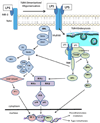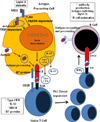The immunobiology of toll-like receptor 4 agonists: from endotoxin tolerance to immunoadjuvants
- PMID: 23989337
- PMCID: PMC3919163
- DOI: 10.1097/SHK.0000000000000042
The immunobiology of toll-like receptor 4 agonists: from endotoxin tolerance to immunoadjuvants
Abstract
Lipopolysaccharide (LPS, endotoxin) is a structural component of the gram-negative outer membrane. The lipid A moiety of LPS binds to the LPS receptor complex expressed by leukocytes, endothelial cells, and parenchymal cells and is the primary component of gram-negative bacteria that is recognized by the immune system. Activation of the LPS receptor complex by native lipid A induces robust cytokine production, leukocyte activation, and inflammation, which is beneficial for clearing bacterial infections at the local level but can cause severe systemic inflammation and shock at higher challenge doses. Interestingly, prior exposure to LPS renders the host resistant to shock caused by subsequent LPS challenge, a phenomenon known as endotoxin tolerance. Treatment with lipid A has also been shown to augment the host response to infection and to serve as a potent vaccine adjuvant. However, the adverse effects associated with the pronounced inflammatory response limit the use of native lipid A as a clinical immunomodulator. More recently, analogs of lipid A have been developed that possess attenuated proinflammatory activity but retain attractive immunomodulatory properties. The lipid A analog monophosphoryl lipid A exhibits approximately 1/1,000th of the toxicity of native lipid A but retains potent immunoadjuvant activity. As such, monophosphoryl lipid A is currently used as an adjuvant in several human vaccine preparations. Because of the potency of lipid A analogs as immunoadjuvants, numerous laboratories are actively working to identify and develop new lipid A mimetics and to optimize their efficacy and safety. Based on those characteristics, lipid A analogs represent an attractive family of immunomodulators.
Conflict of interest statement
There is no conflict of interest
Figures




References
-
- Schweizer HP. Understanding efflux in Gram-negative bacteria: opportunities for drug discovery. Expert Opin Drug Discov. 2012;7(7):633–642. Epub 2012/05/23. doi: 10.1517/17460441.2012.688949. PubMed PMID: 22607346. - PubMed
-
- Schmidt H, Hansen G, Singh S, Hanuszkiewicz A, Lindner B, Fukase K, et al. Structural and mechanistic analysis of the membrane-embedded glycosyltransferase WaaA required for lipopolysaccharide synthesis. Proc Natl Acad Sci U S A. 2012;109(16):6253–6258. Epub 2012/04/05. doi: 10.1073/pnas.1119894109. PubMed PMID: 22474366; PubMed Central PMCID: PMC3341020. - PMC - PubMed
-
- Kalis C, Kanzler B, Lembo A, Poltorak A, Galanos C, Freudenberg MA. Toll-like receptor 4 expression levels determine the degree of LPS-susceptibility in mice. Eur J Immunol. 2003;33(3):798–805. Epub 2003/03/05. doi: 10.1002/eji.200323431. PubMed PMID: 12616500. - PubMed
-
- Park BS, Song DH, Kim HM, Choi BS, Lee H, Lee JO. The structural basis of lipopolysaccharide recognition by the TLR4-MD-2 complex. Nature. 2009;458(7242):1191–1195. Epub 2009/03/03. doi: 10.1038/nature07830. PubMed PMID: 19252480. - PubMed
-
- Asai Y, Hashimoto M, Fletcher HM, Miyake K, Akira S, Ogawa T. Lipopolysaccharide preparation extracted from Porphyromonas gingivalis lipoprotein-deficient mutant shows a marked decrease in toll-like receptor 2-mediated signaling. Infect Immun. 2005;73(4):2157–2163. Epub 2005/03/24. doi: 10.1128/IAI.73.4.2157-2163.2005. PubMed PMID: 15784558; PubMed Central PMCID: PMC1087447. - PMC - PubMed
Publication types
MeSH terms
Substances
Grants and funding
LinkOut - more resources
Full Text Sources
Other Literature Sources
Research Materials

